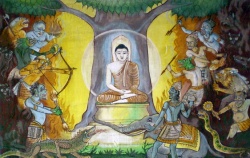Difference between revisions of "Three cycles of preaching"
| (4 intermediate revisions by 2 users not shown) | |||
| Line 1: | Line 1: | ||
| − | 60.jpg | + | [[File:60.jpg|thumb|250px|]] |
<poem> | <poem> | ||
| − | + | [[three cycles of preaching]] | |
| − | [三周の説法] (Jpn sanshu-no-seppo ) | + | [[三周の説法]] (Jpn [[sanshu-no-seppo]] ) |
| − | Three cycles of preaching described in the [[Lotus Sutra]], in which [[Shakyamuni]] [[Buddha's]] voice-hearer [[disciples]] [[grasp]] the [[doctrine]] of the "replacement of the three vehicles with the one [[vehicle]]." The [[doctrine]] reveals that the three vehicles—the teachings for [[voice-hearers]], [[cause-awakened ones]], and bodhisattvas—are not ends in themselves, as the [[Buddha]] had taught in [[sutras]] other than the [[Lotus]], but expedient means by which he leads [[people]] to the one [[vehicle]] of [[Buddhahood]]. Each of the three cycles consists of [[Shakyamuni's]] preaching, his [[disciples]]' understanding what he has preached, and his bestowal of a prediction of future [[enlightenment]] upon his [[disciples]]. The three cycles of preaching occur in the eight chapters of the [[Lotus Sutra]] from "Expedient Means" (second) through "Prophecies" (ninth), and the three correspond respectively to three groups of [[disciples]] [[Shakyamuni]] teaches: those of superior, intermediate, and inferior capacity. | + | Three cycles of preaching described in the [[Lotus Sutra]], in which [[Shakyamuni]] [[Buddha's]] [[voice-hearer]] [[disciples]] [[grasp]] the [[doctrine]] of the "replacement of the [[three vehicles]] with the one [[vehicle]]." The [[doctrine]] reveals that the three vehicles—the teachings for [[voice-hearers]], [[cause-awakened ones]], and bodhisattvas—are not ends in themselves, as the [[Buddha]] had taught in [[sutras]] other than the [[Lotus]], but [[expedient means]] by which he leads [[people]] to the one [[vehicle]] of [[Buddhahood]]. Each of the three cycles consists of [[Shakyamuni's]] preaching, his [[disciples]]' [[understanding]] what he has {{Wiki|preached}}, and his bestowal of a {{Wiki|prediction}} of {{Wiki|future}} [[enlightenment]] upon his [[disciples]]. The three cycles of preaching occur in the eight chapters of the [[Lotus Sutra]] from "[[Expedient Means]]" (second) through "{{Wiki|Prophecies}}" (ninth), and the three correspond respectively to three groups of [[disciples]] [[Shakyamuni]] teaches: those of {{Wiki|superior}}, [[intermediate]], and {{Wiki|inferior}} capacity. |
[[File:90698 n.jpg|thumb|250px|]] | [[File:90698 n.jpg|thumb|250px|]] | ||
| − | First, in the "Expedient Means" chapter, [[Shakyamuni]] preaches the [[doctrine]] of the true aspect of all [[phenomena]] and replaces the three vehicles with the one [[vehicle]], i.e., that his [[disciples]] must abandon the three vehicles and accept the one [[vehicle]]. [[Shariputra]], who is of superior capacity, [[understands]] [[Shakyamuni's]] preaching, and his [[enlightenment]] is then predicted in the "Simile and [[Parable]]" (third) chapter. | + | First, in the "[[Expedient Means]]" chapter, [[Shakyamuni]] preaches the [[doctrine]] of the true aspect of all [[phenomena]] and replaces the [[three vehicles]] with the one [[vehicle]], i.e., that his [[disciples]] must abandon the [[three vehicles]] and accept the one [[vehicle]]. [[Shariputra]], who is of {{Wiki|superior}} capacity, [[understands]] [[Shakyamuni's]] preaching, and his [[enlightenment]] is then predicted in the "Simile and [[Parable]]" (third) chapter. |
| − | Second, in the "Simile and [[Parable]]" chapter, [[Shakyamuni]] relates the [[parable]] of the three carts and the burning house for those who have failed [[ | + | Second, in the "Simile and [[Parable]]" chapter, [[Shakyamuni]] relates the [[parable]] of the three carts and the [[burning house]] for those who have failed to understand the [[principle]]. [[Maudgalyayana]], [[Mahakashyapa]], [[Katyayana]], and [[Subhuti]], who are of [[intermediate]] capacity, understand the [[Buddha's]] {{Wiki|intention}} through this [[parable]], and their [[enlightenment]] is predicted in the "Bestowal of {{Wiki|Prophecy}}" (sixth) chapter. |
| − | Third, in the "[[Parable]] of the Phantom City" (seventh) chapter, [[Shakyamuni]] reveals the relationship between himself and his [[disciples]] since the remote past, in [[order]] to [[enlighten]] those who have failed | + | Third, in the "[[Parable]] of the Phantom City" (seventh) chapter, [[Shakyamuni]] reveals the relationship between himself and his [[disciples]] since the remote {{Wiki|past}}, in [[order]] to [[enlighten]] those who have failed to understand the meaning of the [[parable]]. [[Purna]], [[Ananda]], [[Rahula]], and many others of {{Wiki|inferior}} capacity, upon [[hearing]] about that relationship with [[Shakyamuni]], understand the [[Buddha's]] {{Wiki|intention}} and thereby [[awaken]] to the one [[Buddha]] [[vehicle]]. Their [[enlightenment]] is predicted in the "Five Hundred [[Disciples]]" (eighth) and "{{Wiki|Prophecies}}" chapters. |
</poem> | </poem> | ||
{{R}} | {{R}} | ||
| Line 16: | Line 16: | ||
[[Category:Buddhist Terms]] | [[Category:Buddhist Terms]] | ||
[[Category:Lotus Sutra]] | [[Category:Lotus Sutra]] | ||
| − | [[Category:Buddha Shakyamuni]] | + | [[Category:Buddha Shakyamuni]]{{BuddhismbyNumber}} |
Latest revision as of 10:21, 22 April 2014
three cycles of preaching
三周の説法 (Jpn sanshu-no-seppo )
Three cycles of preaching described in the Lotus Sutra, in which Shakyamuni Buddha's voice-hearer disciples grasp the doctrine of the "replacement of the three vehicles with the one vehicle." The doctrine reveals that the three vehicles—the teachings for voice-hearers, cause-awakened ones, and bodhisattvas—are not ends in themselves, as the Buddha had taught in sutras other than the Lotus, but expedient means by which he leads people to the one vehicle of Buddhahood. Each of the three cycles consists of Shakyamuni's preaching, his disciples' understanding what he has preached, and his bestowal of a prediction of future enlightenment upon his disciples. The three cycles of preaching occur in the eight chapters of the Lotus Sutra from "Expedient Means" (second) through "Prophecies" (ninth), and the three correspond respectively to three groups of disciples Shakyamuni teaches: those of superior, intermediate, and inferior capacity.
First, in the "Expedient Means" chapter, Shakyamuni preaches the doctrine of the true aspect of all phenomena and replaces the three vehicles with the one vehicle, i.e., that his disciples must abandon the three vehicles and accept the one vehicle. Shariputra, who is of superior capacity, understands Shakyamuni's preaching, and his enlightenment is then predicted in the "Simile and Parable" (third) chapter.
Second, in the "Simile and Parable" chapter, Shakyamuni relates the parable of the three carts and the burning house for those who have failed to understand the principle. Maudgalyayana, Mahakashyapa, Katyayana, and Subhuti, who are of intermediate capacity, understand the Buddha's intention through this parable, and their enlightenment is predicted in the "Bestowal of Prophecy" (sixth) chapter.
Third, in the "Parable of the Phantom City" (seventh) chapter, Shakyamuni reveals the relationship between himself and his disciples since the remote past, in order to enlighten those who have failed to understand the meaning of the parable. Purna, Ananda, Rahula, and many others of inferior capacity, upon hearing about that relationship with Shakyamuni, understand the Buddha's intention and thereby awaken to the one Buddha vehicle. Their enlightenment is predicted in the "Five Hundred Disciples" (eighth) and "Prophecies" chapters.

